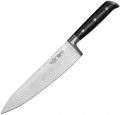Steel grade
The name of the steel grade from which the knife blade is made.
Its working properties directly depend on the type of steel — hardness, brittleness, tendency to corrosion, ability to keep sharpening, etc. Accordingly, this parameter largely determines the features of the knife as a whole. Many different grades of steel are used in modern kitchen knives; knowing the name of a particular brand, you can find detailed information about it (physical characteristics, reviews, user reviews) and evaluate the quality and overall level of the tool.
Blade length
The length of a blade is usually measured from the point to the neck (the bulge between the blade and the handle). The value of this parameter is determined primarily by the type of knife. For example, in
models for cleaning, it rarely exceeds 12 cm — otherwise it would be inconvenient to work with small round products). Among
bread, on the contrary, blades shorter than 20 cm are rarely found — loaves of bread can be quite thick, which requires an appropriate knife, etc. However, knives of the same type can also vary significantly in length. In most cases, you can use this principle: a longer knife allows you to work with larger pieces of food, but it is less “agile”, and the length of the blade can affect the price.
Blade thickness
The thickness of the knife blade at its thickest point (usually at the butt). According to this parameter, one can to some extent evaluate the strength of the blade for transverse loads: a large thickness gives an appropriate margin of safety. At the same time, one should not forget that the “endurance” of a knife as a whole depends on many other features of its design, and only blades made of materials similar in properties can be compared in thickness. But what this indicator directly affects is the weight of the product.
